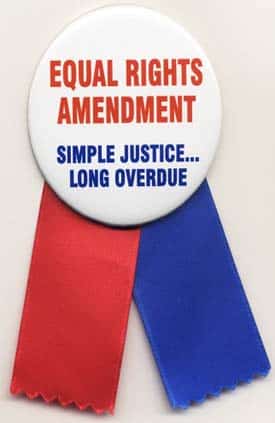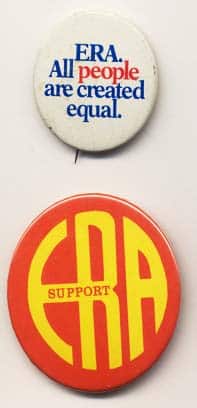by Jennifer S. Macleod
Many established institutions and forces in our country are still fighting desperately against the Equal Rights Amendment because, in one way or another, they substantially benefit — or believe that they benefit — from maintaining whatever is left of the age-old system of male dominance over women.

The Equal Rights Amendment to the U.S. Constitution, or ERA, simply states: “Equality of rights under the law shall not be denied or abridged by the United States or by any state on account of sex.” Added to the U.S. Constitution, the Equal Rights Amendment would make it clear that the United States stands for the full equality of all its citizens, female as well as male.
Passed by Congress in 1972, the ERA has never been ratified by the requisite number of states. Now, equal rights advocates around the country are working to make it a reality by securing the ratification of the needed three more states, or by starting the amending process over to attain passage by Congress and then fresh ratification by the necessary 38 states.
Why are we having so much difficulty in amending the U.S. Constitution in such an obviously timely and essential way?
Cultural History Tells the Story
To answer that question, we have to look back – way back.
All through the tens of thousands of years of human development and history up to only about 150 years ago, a sharp division of labor existed between males and females. This was essential to the generation-by-generation survival of every family, clan, tribe and to humans as a whole. Only the women could gestate and give birth and breastfeed infants. Pregnancy and childbirth were extremely dangerous and often fatal to the mother. Many infants died, as well, and many of those who survived died before reaching the age at which they, too, could reproduce. As a result, almost every woman, for the survival of her human group, had to center her life on successful reproduction.
| Every female child was taught to accept her subjection to male rule. |
Because of that survival necessity, almost all human groups developed cultures, customs, practices, belief systems and institutions – including most religions – that thoroughly enforced the sharp division of labor between the sexes, sometimes through violence. These beliefs held that women were, by their nature and capabilities, suited only for reproduction and related functions, such as gathering food and water, preparing meals for the family and caring for the home. In almost every society, men were fully established as being “properly” dominant over women, and the “owners” and “protectors” of their women and children. Every female child was consistently, day after day, taught to accept her subjection to male rule.
The absolute division between the two sexes, with the men completely dominant over women, became so deeply entrenched in almost all human cultures that it continued in full strength long after it was no longer a survival necessity.
Changing the Paradigm
In the nineteenth century, something remarkable happened. A few courageous women (and some male supporters) began to join together to challenge the beliefs and institutions that had enforced women’s subject status.
But the established beliefs of society in the U.S. included the Constitution, which, when written and adopted by the founding fathers in 1789, codified and perpetuated what was then considered women’s natural and unchangeable subject status. Women who understood the dreadful toll of male dominance and the suppression of women nevertheless persevered, year after year, decade after decade, always against powerful opposition. Their efforts have led to agonizingly slow and intermittent, but nevertheless extraordinary, improvements in the status and opportunities of women.
| Women are held back because of a basic fault in the U.S. Constitution. |
Today, American women continue to advance, but are still held back because of that still-existing basic fault in the U.S. Constitution, that continues to deny them the all-important constitutionally-guaranteed equal rights as citizens. Laws to reduce the numerous ways in which women have been disadvantaged, even when successfully passed, have all too easily and frequently been weakened, overturned, or simply ignored by institutions and courts. For example, Title VII of the Civil Rights Act of 1964 prohibited discrimination in employment on the basis of race, color, religion, national origin and sex, but its application to sex discrimination was delayed for years because to do so was widely regarded as “ridiculous,” episodes vividly described by Gail Collins in her book, America’s Women:400 Years of Dolls, Drudges, Helpmates and Heroines. More recently, Title IX of the Educational Amendments of 1972, that had slowly but greatly reduced sex discrimination in education, including in athletic programs in public schools, was severely weakened by actions of the federal government in the 2000 through 2008 period, despite protestations of NOW and other advocacy groups. Women’s rights organizations and activists are forced to expend much of their effort and time simply to defending past gains.
Today, the pursuit of full constitutional equality for women still faces powerful and well-funded opposition forces fighting a desperate “rear guard action” to retain what is left of the ancient male dominance patterns of human society.

Almost every time an additional state legislature appears close to ratifying the ERA, Phyllis Schlafly, who takes credit for “defeating” the ERA in the 1970s, shows up with her Eagle Forum and other supporters. They bombard legislators not only with the usual political pressures, but also with patently false, but often effective, scare tactics. Their “Stop ERA” campaign claims that if the ERA is passed, the age for consensual sex will be 12; prostitution will be legalized, and everything from prisons to Boy Scout and Girl Scout troops will be sex-integrated. Schlafly’s speech at Bates College on March 28, 2007 included assertions that “women should not be permitted to do jobs traditionally held by men, such as firefighter, soldier or construction worker, because of women’s ‘inherent physical inferiority,’” according to a local Maine newspaper article.
Also in evidence at legislative hearings on the ERA are spokespeople for extremely conservative religious organizations that use ancient religious beliefs regarding women’s status as tools to argue against the ERA. (Eve’s original sin, anyone?)
Advancing Full Equality Regardless of Gender
The extreme no-holds-barred vehemence of the opposition — small in number of adherents, but great in power and resources – points to how significant the ERA will be in achieving major advances toward full legal equality for women. Inevitably, the addition of the ERA to the constitution will permit women (and men when they are the victims of sex discrimination) to proactively challenge and overturn the remaining sex discriminatory aspects of federal, state and local laws. The ERA will have the additional effect of empowering women and their male supporters to actively oppose other still-ingrained sex discriminatory cultural and societal patterns, including damaging assumptions about the comparative abilities and characteristics of girls and boys, men and women.
What is opposition to the ERA really all about? It is a frantic attempt to block, and then reverse, one of the most extraordinary and mighty tides of change in all of human history: the emergence, at last, of the long suppressed female half of the human race to full and equal participation in society and the shaping of a better future for all.
Jennifer S. Macleod, Ph.D., is the co-founder and National Coordinator of ERA Campaign Network. A consultant on social research, now retired, she writes about the advancement of women and is co-author with Sandra Silverman (Souder) of the 1973 book, “‘You Won’t Do’ What Textbooks on U.S. Government Teach High School Girls.” The first president of the founding New Jersey chapter of NOW, she is included in the book
“Feminists Who Changed America 1963-1975,” ed. Barbara J. Love. She can be reached by email at [email protected].
Also see Common Enemies: LGBT, Abortion Share Foes by Pam Chamberlain in this edition of On The Issues Magazine.
See Revolution Lite by Merle Hoffman in the Winter 2009 edition of On The Issues Magazine.
